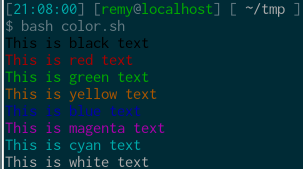Raymii.org

Quis custodiet ipsos custodes?Home | About | All pages | Cluster Status | RSS Feed
Bash Bits: Add colour output to your script
Published: 18-09-2013 | Author: Remy van Elst | Text only version of this article
❗ This post is over eleven years old. It may no longer be up to date. Opinions may have changed.
Bash Bits are small examples and tips for Bash Scripts. This bash bit shows you how to add coloured output to your scripts.
Recently I removed all Google Ads from this site due to their invasive tracking, as well as Google Analytics. Please, if you found this content useful, consider a small donation using any of the options below. It means the world to me if you show your appreciation and you'll help pay the server costs:
GitHub Sponsorship
PCBWay referral link (You get $5, I get $20 after you've placed an order)
Digital Ocea referral link ($200 credit for 60 days. Spend $25 after your credit expires and I'll get $25!)
All Bash Bits can be found using this link
A little background first on how this all works. Coloured output has to be supported by your terminal emulator, but most modern ones support it. It works by sending specific control codes to your terminal.
Terminal (control-)codes are needed to give specific commands to your terminal. A terminal control code is a special sequence of characters that is printed (like any other text). If the terminal understands the code, it won't display the character-sequence, but will perform some action. You can always print the codes with a simple echo command.
Because there's a large number of different terminal control languages, usually a system has an intermediate-layer to talk to it. The real codes are looked up in a database for the currently detected terminal type and you give standardized requests to an API or (from the shell) to a command.
One of these commands is tput - it accepts a set of acronymes and parameters for them, looks up the correct codes for the detected terminal in the terminfo database and prints the correct codes (the terminal hopefully understands).
When I need to use colours in my scripts I often just use red and green. I have a set of functions which I use named after the colour:
black() { echo "$(tput setaf 0)$*$(tput setaf 9)"; }
red() { echo "$(tput setaf 1)$*$(tput setaf 9)"; }
green() { echo "$(tput setaf 2)$*$(tput setaf 9)"; }
yellow() { echo "$(tput setaf 3)$*$(tput setaf 9)"; }
blue() { echo "$(tput setaf 4)$*$(tput setaf 9)"; }
magenta() { echo "$(tput setaf 5)$*$(tput setaf 9)"; }
cyan() { echo "$(tput setaf 6)$*$(tput setaf 9)"; }
white() { echo "$(tput setaf 7)$*$(tput setaf 9)"; }
Then when I need to colourize some output I can just use the function like so:
red "Error: Something went horribly wrong...". Down below you can find sample
code which should print text in all the above defined colours:
black "This is black text"
red "This is red text"
green "This is green text"
yellow "This is yellow text"
blue "This is blue text"
magenta "This is magenta text"
cyan "This is cyan text"
white "This is white text"
This image shows you how it looks on my terminal:

And last but not least here is a bash command which prints out all colour that your terminal supports. Good to test if you have 256 colours enabled or not, plus it shows you the number to use with tput for that colour.
( x=`tput op` y=`printf %$((${COLUMNS}-6))s`;for i in {0..256};do o=00$i;echo -e ${o:${#o}-3:3} `tput setaf $i;tput setab $i`${y// /=}$x;done; )